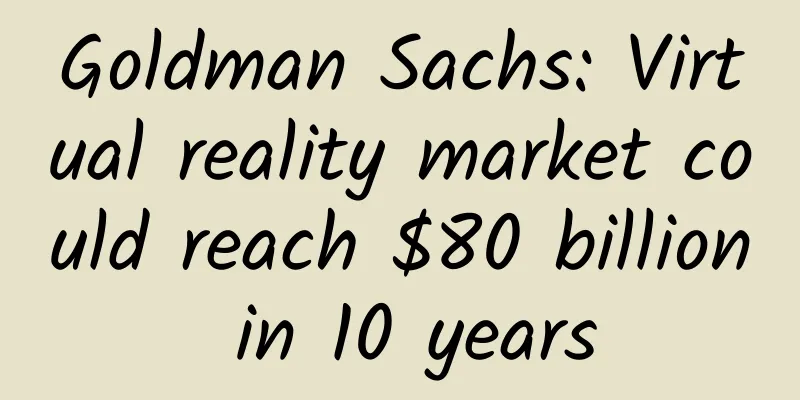Goldman Sachs: Virtual reality market could reach $80 billion in 10 years

|
Many seemingly beautiful technologies always fall inadvertently, even the popular virtual reality (VR), which was popular in the 1990s and can only be regarded as a rebirth now. However, Goldman Sachs said in a report on Wednesday that this time, VR technology will not repeat the mistakes of 20 years ago, and will form a market of tens of billions of dollars and completely change people's lives. So what is different now than in the 1990s to ensure that VR technology will not fail again? Goldman Sachs' answer is "advances in technology."Goldman Sachs said in the report that people's expectations for virtual reality devices in the early 1990s were too high, and the hardware at the time could not achieve the expected effects. However, today's computers are very powerful and can provide users with impressive images. In addition, the rise of smartphones has enabled various sensors and displays to be mass-produced at low prices, reducing the price of virtual reality devices. Nowadays, almost all IT giants including Facebook, Google, Microsoft, Sony, etc. are working on the field of virtual reality. "This means that head-mounted displays (HMDs) will become a new type of computer with great potential," Goldman Sachs said.
VR device ads from the 1990s Sony showcased a lot of new content for its PS VR virtual reality platform at the recent PSX conference, showing that virtual reality technology will make great strides in the gaming field. However, neither Sony nor Oculus, which became popular earlier, are actually the first companies to get involved in consumer-grade virtual reality devices. In the 1990s, as computers became more common, some big companies tried to implement this idea with helmets as an initial attempt. They failed. Computers at the time were incapable of producing a realistic experience. Users were prone to nausea and headaches, and the equipment was expensive and bulky. For example, the Nintendo Virtual Boy, which was launched in 1995, was the first virtual reality home game console. Its novel design concept is still praised by many players today. However, in the Japanese market, Virtual Boy was withdrawn from the shelves after only five months on the market, and it lasted less than a year in the US market. In the end, the global sales volume was less than 1 million units. From a market perspective, it was indeed a failed device.
Why did Virtual Boy fail? Obviously, it had a lot to do with the immaturity of virtual reality technology at the time. First, the Virtual Boy was not designed to be a completely portable headset. It needed to be placed on a table, and players had to put their heads close to the device to use it. Second, many users experienced obvious dizziness and even headaches after using it, which was obviously not a pleasant gaming experience. In addition, the Virtual Boy was also extremely expensive. The price of $180 was not really competitive at the time, especially when the gaming experience was not good.
Times have changed. Today's technological development has undergone tremendous changes compared to 20 years ago. Goldman Sachs said that VR technology will be used not only in games, but also in many fields (such as medical and industrial). Just like computers have changed people's lives, VR technology will also change people's lifestyles. Goldman Sachs estimates that AR (augmented reality) and VR hardware and software revenues will reach $80 billion by 2025, and if they quickly move beyond the niche market to the masses, annual revenues could reach as much as $182 billion. Considering that the industry may take some time to resolve delays and other technical issues, even at the slowest pace, the VR and AR industry's annual revenues will be $23 billion by 2025. If Goldman Sachs's forecast is correct, the VR and AR markets will become larger than the TV market by 2025, reaching $110 billion, while the TV market is only $99 billion. This is very likely to happen, because improvements in battery and cellular network technology will lead to accelerated development of the VR industry. Then high-end VR helmets will abandon cables and supporting computers and become truly mobile devices. Oculus also said a year ago that their long-term goal is to allow 1 billion people to use VR, and in the future they will be able to provide a comfortable VR experience on sunglasses. However, Goldman Sachs also stated that compared with the smartphone and tablet business, the speed at which VR/AR technology is accepted by consumers will be relatively slow, but "as technology improves, prices fall, and entire new application markets (including enterprise and consumer application markets) come to market, we believe that virtual reality and augmented reality businesses have great potential to become a multi-billion dollar market and have the potential to change the rules of the game like the emergence of personal computers."
|
<<: Why are Silicon Valley CEOs obsessed with artificial intelligence?
>>: Google reorganizes secretive R&D department Google X: new logo unveiled
Recommend
The three major responsibilities of operators: attracting new customers, converting customers, and extending the life cycle
Operations can transform you into a wedding night...
Gansu Province's TCM Prevention and Treatment Plan for Pneumonia Infected by the New Coronavirus (Trial)
This disease belongs to the category of "epi...
Report | Research report on the marketing effectiveness of information flow advertising in 8 major industries
In recent years, information flow ads have become...
Use "copywriting sentence patterns" to create memorable and highly popular copywriting
If you are sensitive to hot topics, I believe you...
A sideline business with zero threshold to make money, with a monthly income of 20,000+ for beginners
At present, everyone knows that the short video i...
The “knowledge” in “knowledge payment” is as much about “sharing” as the “sharing economy”
1 In “ knowledge payment ”, the “knowledge” compo...
Will the May Day Expressway be free in 2022? How many days is it free? Attached is the latest notice on free passage time!
There are two short holidays in April and May ever...
5 major growth types of brand marketing!
First, let me say the golden sentence: Five growt...
How to write good ideas efficiently through information flow?
Recently I received a secret report: it said that...
Keywords and cases of seed user operations for different types of products
Content "attraction", "vest" ...
"The best time, never seen before" Cisco's three brand transformations
“We are technology optimists,” wrote Karen Walker...
3 major trends in social media operations in 2019!
The times are constantly advancing and trends are...
Share a relatively unpopular and profitable project with poor information. Someone made 60,000 in 3 months
Today I will share with you a relatively unpopula...
Advanced ways to attract traffic to Douyin live streaming room
“If we want to increase the popularity of our liv...
From 0 to 1, the secret of starting new media operations
Nowadays, both Internet companies and traditional...









